
Kanishka I, Kanishka or Kanishka the Great, was an emperor of the Kushan dynasty, under whose reign the empire reached its zenith. He is famous for his military, political, and spiritual achievements. A descendant of Kujula Kadphises, founder of the Kushan empire, Kanishka came to rule an empire extending from Central Asia and Gandhara to Pataliputra on the Gangetic plain. The main capital of his empire was located at Puruṣapura (Peshawar) in Gandhara, with another major capital at Mathura. Coins of Kanishka were found in Tripuri.
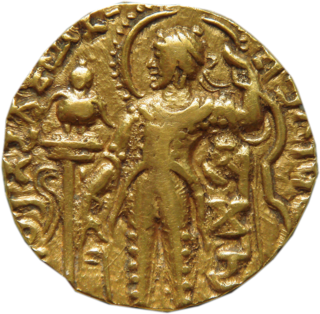
Samudragupta (Gupta script: Sa-mu-dra-gu-pta, was the second emperor of the Gupta Empire of ancient India, and is regarded among the greatest rulers of India. As a son of the Gupta emperor Chandragupta I and the Licchavi princess Kumaradevi, he greatly expanded his dynasty's political and military power. Samudragupta remained undefeated during his entire reign and is considered one of the greatest emperors in the history of the world. During his and his son, Chandragupta II's rule the Gupta Empire was undoubtedly the strongest and the most powerful empire in the world at that time.
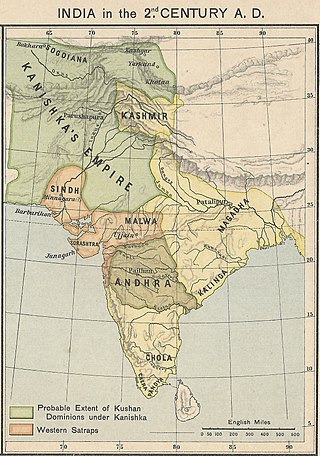
The Kushan Empire was a syncretic empire formed by the Yuezhi in the Bactrian territories in the early 1st century. It spread to encompass much of what is now Uzbekistan, Afghanistan, Pakistan, and Northern India, at least as far as Saketa and Sarnath, near Varanasi, where inscriptions have been found dating to the era of the Kushan emperor Kanishka the Great.
Gandhāra was an ancient Indo-Aryan civilization centered in the present-day north-west Pakistan and north-east Afghanistan, roughly in the northwestern part of South Asia. The core of the region of Gandhara was the Peshawar and Swat valleys, though the cultural influence of "Greater Gandhara" extended across the Indus river to the Taxila region in Potohar Plateau and westwards into the Kabul valley in Afghanistan, and northwards up to the Karakoram range.

Kujula Kadphises was a Kushan prince who united the Yuezhi confederation in Bactria during the 1st century CE, and became the first Kushan emperor. According to the Rabatak inscription, he was the great grandfather of the great Kushan king Kanishka I. He is considered the founder of the Kushan Empire.

Vima Kadphises was a Kushan emperor from approximately 113 to 127 CE. According to the Rabatak inscription, he was the son of Vima Takto and the father of Kanishka.

Huvishka was the emperor of the Kushan Empire from the death of Kanishka until the succession of Vasudeva I about thirty years later.

Vāsudeva I was a Kushan emperor, last of the "Great Kushans." Named inscriptions dating from year 64 to 98 of Kanishka's era suggest his reign extended from at least 191 to 232 CE. He ruled in Northern India and Central Asia, where he minted coins in the city of Balkh (Bactria). He probably had to deal with the rise of the Sasanians and the first incursions of the Kushano-Sasanians in the northwest of his territory.
The Indo-Parthian Kingdom was a Parthian kingdom founded by Gondophares, and active from 19 CE to c. 226 CE. At their zenith, they ruled an area covering parts of eastern Iran, various parts of Afghanistan and the northwest regions of the Indian subcontinent. The rulers may have been members of the House of Suren, and the kingdom has even been called the "Suren Kingdom" by some authors.

Indo-Scythians were a group of nomadic Iranian peoples of Scythian origin who migrated from Central Asia southward into the northwestern Indian subcontinent, precisely into the modern-day South Asian regions of Afghanistan, Pakistan and northern India. The migrations persisted from the middle of the 2nd century BCE to the 4th century CE.
The Kidarites, or Kidara Huns, were a dynasty that ruled Bactria and adjoining parts of Central Asia and South Asia in the 4th and 5th centuries. The Kidarites belonged to a complex of peoples known collectively in India as the Huna, and in Europe as the Chionites, and may even be considered as identical to the Chionites. The 5th century Byzantine historian Priscus called them Kidarite Huns, or "Huns who are Kidarites". The Huna/Xionite tribes are often linked, albeit controversially, to the Huns who invaded Eastern Europe during a similar period. They are entirely different from the Hephthalites, who replaced them about a century later.

Sodasa was an Indo-Scythian Northern Satrap and ruler of Mathura during the later part of the 1st century BCE or the early part of 1st century CE. He was the son of Rajuvula, the Great Satrap of the region from Taxila to Mathura. He is mentioned in the Mathura lion capital.
The Western Satraps, or Western Kshatrapas were Indo-Scythian (Saka) rulers of the western and central parts of India, between 35 and 415 CE. The Western Satraps were contemporaneous with the Kushans who ruled the northern part of the Indian subcontinent, and were possibly vassals of the Kushans. They were also contemporaneous with the Satavahana (Andhra) who ruled in Central India. They are called "Western Satraps" in modern historiography in order to differentiate them from the "Northern Satraps", who ruled in Punjab and Mathura until the 2nd century CE.
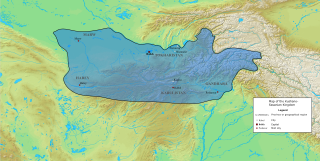
Kushano-Sasanian Kingdom is a historiographic term used by modern scholars to refer to a branch of the Sasanian Persians who established their rule in Bactria during the 3rd and 4th centuries CE at the expense of the declining Kushans. They captured the provinces of Sogdiana, Bactria and Gandhara from the Kushans in 225 CE. The Sasanians established governors for the Sasanian Empire, who minted their own coinage and took the title of Kushanshas, i.e. "Kings of the Kushans". They are sometimes considered as forming a "sub-kingdom" inside the Sasanian Empire. This administration continued until 360-370 CE, when the Kushano-Sasanians lost much of its domains to the invading Kidarite Huns, whilst the rest was incorporated into the imperial Sasanian Empire. Later, the Kidarites were in turn displaced by the Hephthalites. The Sasanians were able to re-establish some authority after they destroyed the Hephthalites with the help of the Turks in 565, but their rule collapsed under Arab attacks in the mid 7th century.
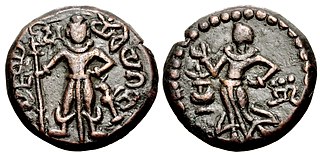
Yaudheya (Brahmi script: 𑀬𑁅𑀥𑁂𑀬) or Yoddheya Gana (Yoddheya Republic) was an ancient militant confederation based in the Eastern region of the Sapta Sindhu. The word Yaudheya is a derivative of the word from yodha meaning warriors and according to Pāṇini, the suffix '-ya', was significant of warrior tribes, which is supported by their resistance to invading empires such as the Kushan Empire and the Indo-Scythians. Rudradaman I of the Western Satraps notes in his Junagadh rock inscription that the Yaudheyas were 'heroes among all Kshatriya' and 'were loath to surrender'. They were noted as having a republic form of government, unique from other Janapadas which instead maintained monarchies.
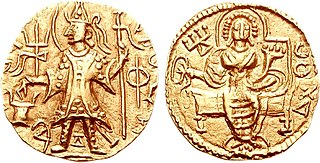
Vāsishka was a Kushan emperor, who seems to have had a short reign following Kanishka II.

Joe Cribb is a numismatist, specialising in Asian coinages, and in particular on coins of the Kushan Empire. His catalogues of Chinese silver currency ingots, and of ritual coins of Southeast Asia were the first detailed works on these subjects in English. With David Jongeward he published a catalogue of Kushan, Kushano-Sasanian and Kidarite Hun coins in the American Numismatic Society New York in 2015. In 2021 he was appointed Adjunct Professor of Numismatics at Hebei Normal University, China.

The Naga dynasty ruled parts of north-central India during the 3rd and the 4th centuries, after the decline of the Kushan Empire and before the rise of the Gupta Empire. Its capital was located at Padmavati, which is identified with modern Pawaya in Madhya Pradesh. Modern historians identify it with the family that is called Bharashiva in the records of the Vakataka dynasty.

The Wardak Vase is an ancient globular-shaped buddhist copper vase that was found as part of a stupa relic deposit in the early nineteenth century in the Wardak Province of Afghanistan. The importance of the vase lies in the long Kharoshthi inscription which dates the objects to around 178 AD and claims that the stupa contained the sacred relics of the Buddha. Since 1880, the vase has been part of the British Museum's Asian collection.

Hormizd I Kushanshah was Kushanshah of the Kushano-Sasanian Kingdom from 275 to 300. His reign was marked by his rebellion against his brother and suzerain the Sasanian King of Kings Bahram II.

 in the Brahmi script appears under the left arm of the ruler.
in the Brahmi script appears under the left arm of the ruler.![]() Chhu) seems to have been a late Kushan Empire ruler, who ruled from 310 to 325 CE. [2] His coinage is very similar to that of his near-contemporary Vasudeva. [3] His rule corresponds to the last days of the Kushan Empire, before the conquest by Kidara. [4]
Chhu) seems to have been a late Kushan Empire ruler, who ruled from 310 to 325 CE. [2] His coinage is very similar to that of his near-contemporary Vasudeva. [3] His rule corresponds to the last days of the Kushan Empire, before the conquest by Kidara. [4] 
















